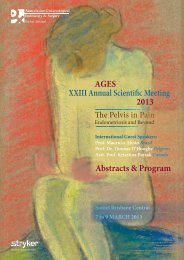to Obstetric Trauma Pelvic Floor Repair Surgical Essentials - AGES
to Obstetric Trauma Pelvic Floor Repair Surgical Essentials - AGES
to Obstetric Trauma Pelvic Floor Repair Surgical Essentials - AGES
You also want an ePaper? Increase the reach of your titles
YUMPU automatically turns print PDFs into web optimized ePapers that Google loves.
Free<br />
Communications<br />
Session 7C<br />
Saturday<br />
4 June<br />
Session 7 - Free Communications C<br />
1430-1440<br />
Uterus-sparing prolapse surgery: Is<br />
laparoscopic repair better than the<br />
transvaginal approach<br />
Patel PS, Dunkley EJC, Kaufman Y, Lam A<br />
While the benefits of abdominal sacral colpopexy compared <strong>to</strong><br />
vaginal sacrospinous colpopexy has been established 1 , there is<br />
limited evidence <strong>to</strong> suggest that laparoscopic sacral colpopexy is<br />
superior <strong>to</strong> transvaginal mesh repair. The evidence is even scarcer<br />
when considering uterine-preservation at the time of surgery. Our<br />
objective was <strong>to</strong> compare the outcomes of laparoscopic mesh<br />
sacrohysteropexy (LSH) with transvaginal Prolift ® mesh repair for<br />
uterovaginal prolapse.<br />
This prospective cohort study included all patients who presented <strong>to</strong><br />
our tertiary referral centre with prolapse, and underwent LSH using<br />
Gynemesh ® or transvaginal Prolift ® repair with an intact uterus,<br />
between November 2004 and December 2010.<br />
Patients’ responses <strong>to</strong> standardised questions on bowel, bladder and<br />
sexual function, and objective pelvic exam findings using the pelvic<br />
organ prolapse quantification (POP-Q) scale, were documented at<br />
pre-operative and routine post-operative visits at 1- and 12-months,<br />
as well as at any unscheduled visits.<br />
The primary outcome was objective ana<strong>to</strong>mic cure, defined as<br />
a POP-Q stage of ≤1. Secondary outcomes included subjective<br />
cure, operative morbidity, including, intra-operative complications,<br />
operative duration, estimated blood loss, and immediate and longterm<br />
post-operative complications, such as mesh erosions, de novo<br />
stress incontinence and dyspareunia, and re-operation rates for<br />
prolapse or incontinence.<br />
REFERENCE:<br />
1. Maher C, Feiner B, Baessler K, Glazener CMA. <strong>Surgical</strong><br />
management of pelvic organ prolapse in women. Cochrane<br />
Database of Systematic Reviews 2010, Issue 4. Art. No.:<br />
CD004014. DOI: 10.1002/14651858.CD004014.pub4.<br />
AUTHOR AFFILIATION: P. S. Patel, E. J. C. Dunkley, Y. Kaufman,<br />
A. Lam; Centre for Advanced Reproductive Endosurgery (CARE), St<br />
Leonards, NSW, Australia.<br />
Session 7 - Free Communications C<br />
1440-1450<br />
A comparison of two mesh systems<br />
for repair of pelvic organ prolapse<br />
Dunkley EJC, Patel PS, Lam A<br />
INTRODUCTION: Vaginal mesh systems for the repair of pelvic<br />
organ prolapse have been used for some time now. Major benefits<br />
of these systems are a reduced rate of recurrence and vaginal<br />
stenosis. Concerns about infection and mesh erosion still exist and<br />
long term results are not available for some newer systems.<br />
AIM: The aim of this presentation is <strong>to</strong> compare early outcomes<br />
from two different mesh systems (Prolift® and Elevate®) for repair<br />
of symp<strong>to</strong>matic pelvic organ prolapse.<br />
METHODS: All patients receiving vaginal mesh repair for prolapse<br />
in a single tertiary referral centre underwent pre-op standardised<br />
questioning, pre and post-op POP-Q assessment and recording of<br />
intra-operative results and post-operative complications. Quality<br />
of life assessments were also made. Follow-up schedule involved<br />
review at 6 weeks and 1 year with unscheduled visits if required.<br />
RESULTS: There were 195 Prolift® mesh procedures in 114 women<br />
with POP Q stage ≥2 pre-operatively. There was a mean follow-up<br />
of these women of 7 months. There were 164 Elevate® procedures<br />
in 108 women with POP Q stage ≥2. There was a mean follow-up<br />
of 2.4 months in this group <strong>to</strong> date. The baseline characteristics<br />
of the two groups were comparable with regards <strong>to</strong> average age,<br />
BMI, parity, sexual activity and menopausal status. Intra-operative,<br />
early and late post-operative complications will be compared as will<br />
outcomes in terms of symp<strong>to</strong>m resolution and ana<strong>to</strong>mical result. A<br />
difference in mesh erosion rates between the two mesh systems will<br />
be discussed.<br />
CONCLUSIONS: Both mesh systems are safe with good overall<br />
ana<strong>to</strong>mical outcomes. However, Elevate ® has reduced early<br />
complications, particularly with regards <strong>to</strong> early mesh erosion, in this<br />
patient series.<br />
AUTHOR AFFILIATION: E. J. C. Dunkley, P. S. Patel, A. Lam; Centre<br />
for Advanced Reproductive Endosurgery (CARE), St Leonards, NSW,<br />
Australia.<br />
29

















